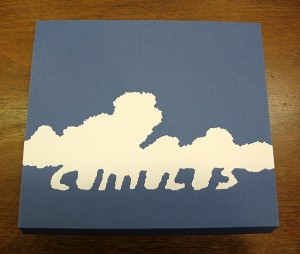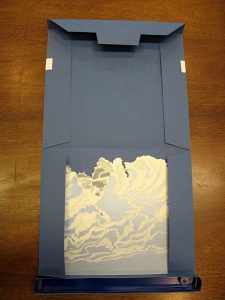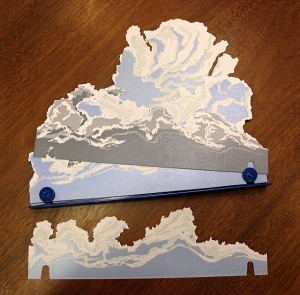
Through the generosity of a donor (who is also on the staff of the Smithsonian Libraries!), the American Art Museum/National Portrait Gallery Library (AA/PG Library) is pleased to announce a new addition to its artists’ book collection: Cumulus by Thomas Parker Williams.
Although many of the over 200 artists’ books in the AA/PG Library collection are in the traditional codex format (the familiar book with a spine on one side where the pages are held together), many artists take advantage of the medium to push the boundaries of the book form. For example, a book featured in an earlier blog post, The Quilts of Gee’s Bend, Vol. 2 really confronts the definition of what can be considered a “page.”
Many book artists have experimented with the idea of cards as pages which allows the viewer rearrange the order or narrative without being restricted by the stricture of a spine. Don Celender’s Artball and George Brecht’s Water Yam are two well-known examples that are held in the library.

Thomas Parker Williams, an artist from Philadelphia, PA and the creator of Cumulus also experiments with cards as pages of the artists’ book. However each one of his pages takes a different shape. The five “pages” of the book are double-sided cut-outs of clouds – each a different shape. The clouds are printed using the reductive linocut printing method. This process is similar to woodcut printing, except with linoleum rather than wood. It is “reductive” because as each successive color is applied, the previous layer of the linoleum is cleaned and further cuts are made in the areas that will not be imprinted on the next printing. As you can imagine, this technique leave very little room for error! Each card is printed on both sides – one side depicts clouds in fair weather and the other depicts storm clouds. Naturally the title of the book refers to the type of clouds that are depicted. Cumulus clouds are common puffy, low level clouds that generally have flat bases, which makes them ideal for fitting a metal base which serves as the “spine” for the “pages.”

The clouds can be arranged in any order and can overlapped in different ways to create many different sculptural results. As a result the artwork can be considered a collaboration between the book artist and the viewer. Certainly experiencing this book is quite different from flipping the pages in a typical book and at the same time enjoying the artwork is a participatory event. We’re delighted to have it in the collection.
This book has an edition of 50 (AA/PG Library’s is number 30).

One Comment
[…] relevance to the history of science and technology. The books include Thomas Parker Williams’ Cumulus with cut-out clouds of different shapes forming a changeable diorama, a shadow theatre version […]